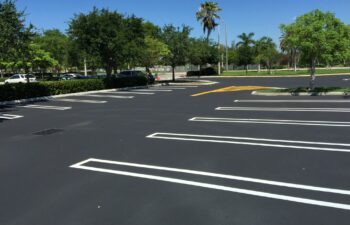
Selecting the right paint for striping parking lots is crucial for property managers, business owners, and parking lot maintenance professionals. This article aims to guide you through the complexities of choosing the most suitable paint, enhancing the longevity and safety of your parking lot markings.
Types of Parking Lot Paint
- Waterborne Paints: Commonly used due to their ease of use and minimal fumes, waterborne paints are ideal for lots sealed with coal tar products. They perform poorly under 50°F, limiting their use in cooler climates.
- Chlorinated Rubber: More expensive than waterborne paints, chlorinated rubber paint offers quick drying times and superior durability. It works well in a range of temperatures, extending the striping season in cooler climates.
- Reflective Paints: These paints, enhanced with glass beads, provide excellent visibility at night and in poor weather conditions. Reflective paints are used in both waterborne and chlorinated rubber varieties.
- Thermal Plastic Paints: Known for their durability, these paints are thick and raised, ideal for harsh conditions. However, they are significantly more expensive and not typically used for ordinary striping.
- Oil-Based Paints: Durable and long-lasting, oil-based paints are suitable for various weather conditions. They require less maintenance but are avoided in some areas due to environmental concerns.
- Canned Aerosol Line Striping Paint: An easy solution for property managers maintaining their parking lots, these paints are suitable for professional results and are available in multiple colors.
Durability and Longevity
The durability of parking lot paint is influenced by traffic volume, climate, and maintenance. Oil-based paints offer the most durability, especially in varied weather conditions, while water-based options are more susceptible to environmental wear.
Visibility and Safety
High visibility is essential for parking lot markings. Reflective paints, containing glass beads, significantly enhance visibility at night and in adverse weather conditions, contributing to the safety of the parking lot.
Regulatory Compliance
Local and federal regulations may dictate the type of paint to be used for parking lot striping. Compliance is crucial to avoid legal repercussions and ensure safety standards.
Cost Analysis
Consider the initial cost, maintenance expenses, and lifespan of different paints. While thermal plastic and oil-based paints may have higher upfront costs, their longevity might offer better cost-efficiency over time.
Application Techniques
Proper application is vital for lasting results. This includes surface preparation, appropriate line width, and respecting drying times. For oil-based paints, ensure a minimum temperature of 50°F, and for water-based, a minimum of 60°F.
Maintenance Tips
Regular inspections, re-striping schedules, and minor repairs extend the life of parking lot markings. Consider restriping every two years to maintain visibility and compliance.
Let Us Stripe Your Parking Lots for You!
Choosing the right paint for parking lot striping is a balance between durability, visibility, and compliance. Understanding the different types of paints and their properties helps in making an informed decision. For expert advice on parking lot maintenance and striping services, don’t hesitate to contact U.S. Pave.
Posted on behalf of
U.S. Pave is a full-service paving maintenance and installation company serving all of Florida with Parking Lot Maintenance, New Asphalt Construction, Asphalt Patching and Repair, Parking Lot Crack Repair, Pothole Repair, Parking Lot Resurfacing (Overlay), Parking Lot Sealcoating or Resealing, Concrete Maintenance, Concrete Flatwork, Concrete Car Stops, Flow line / Curb & Gutter, Trip-hazard Removal/Grinding, Parking Lot Striping, Signage, Bollards, ADA Compliance and Upgrades, Catch Basins, Sweeping and Porter Services.
Whether you’re in need of a small repair or a new construction project, U.S. Pave's dedicated team has you covered.
For more information on our services contact us today at (954) 210-7481.



